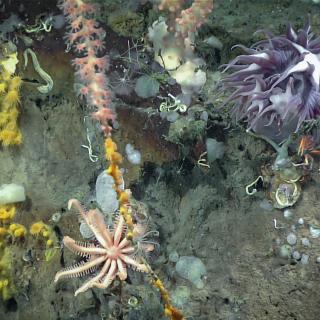Elasmobranches of Palau: Lanternshark and Deepwater Stingray
The elasmobranches came out to play while we were diving ROV Hercules approximately 75 nm southeast of Merir Island on the (currently unnamed) shallowest seamount so far identified within the Palau National Marine Sanctuary. Lanternsharks, like the juvenile seen here, are bioluminescent in a special pattern called aposematic bioluminescence. Similar to how birds or butterflies use coloration as a deterrent signal to predators, scientists speculate that this glowing, especially featuring the large spines around the animal's body, helps them avoid predators. The other elasmobranch spotted in this highlight video is a deepwater stingray (Plesiobatis) at around 695 meters deep. Watch as the Corps of Exploration enjoy following this pancake-shaped marine predator that preys upon crustaceans, cephalopods, and bony fishes.
The NA168 Lebuu’s Voyage expedition to explore the deep sea inside and around the Palau National Marine Sanctuary was conducted in partnership with the Palau International Coral Reef Center and funded by NOAA Ocean Exploration via the Ocean Exploration Cooperative Institute. It was named Lebuu’s Voyage by Palauan stakeholders as part of a strategic effort to advance traditional knowledge and best practices in tandem with scientific understanding.

Lebuu's Voyage II - Palau
Building on the progress in the first expedition, this 11-day expedition will continue exploring Palau National Marine Sanctuary (PNMS) to understand seafloor features and the biodiversity that call deep sea habitats around Palau home. Specific cruise objectives will continue to be refined as we work with community and scientific partners.



